Roma tomato is one of the most popular varieties of tomatoes, and for a good reason! They’re perfect for making sauces, canning, and drying. But what if you want to grow your own Roma tomatoes? If you’re looking for a Roma tomato growing guide, you’ve come to the right place. This blog post will cover everything you need to know about growing Roma tomatoes, including tips for success in pots, ground, raised beds, and buckets.
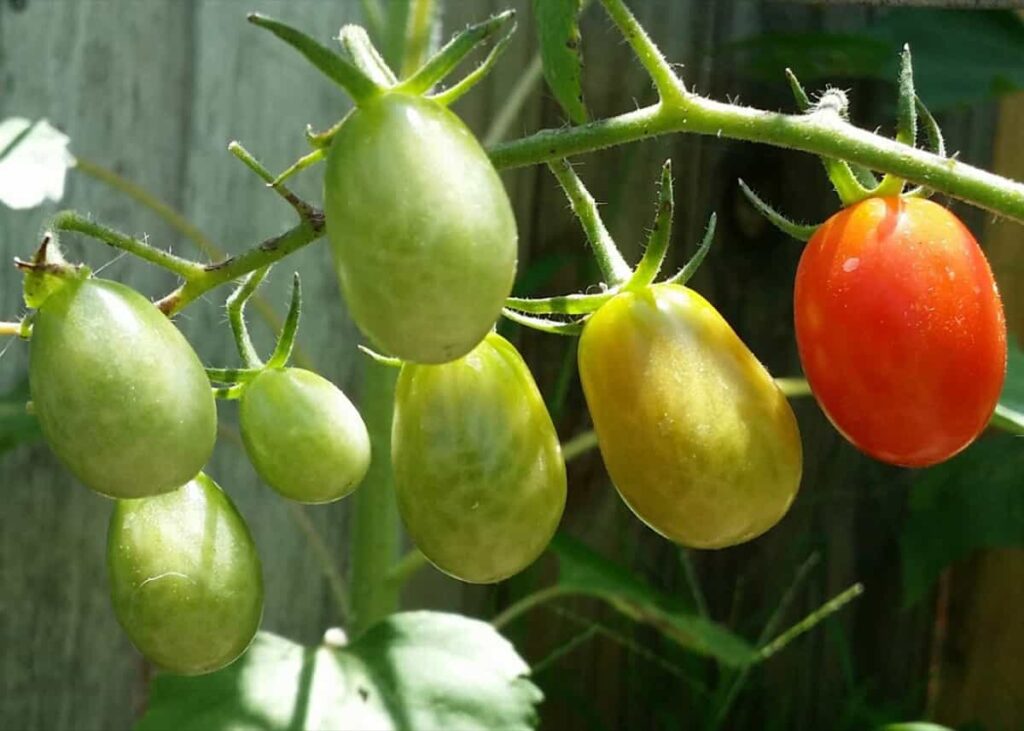
Roma tomato growing guide
What are Roma tomatoes?
Roma tomatoes are a popular tomato often used in sauces, soups, and other dishes. They are a pear-shaped variety with firm flesh and few seeds. Roma tomatoes typically have a deep red color and are slightly acidic in flavor.
Are Roma tomatoes determinate or indeterminate?
Roma tomatoes are determinate tomatoes, meaning they grow to a specific size and then stop growing. This makes them ideal for growing in smaller spaces, like containers or gardens. Usually, indeterminate tomatoes continue to grow and produce fruit throughout the growing season. While you can certainly grow Roma tomatoes in a larger garden, they may not produce as much fruit as an indeterminate variety.
Soil requirement for growing Roma tomatoes
Roma tomatoes are a versatile and easy-to-grow variety that can be grown in various soil types. However, they do best in well-drained, fertile soils with a pH between 6.0 and 7.0. Roma tomatoes are relatively tolerant of poor soils, but if you want to produce the highest yields possible, it’s worth preparing your soil properly before planting.
If your soil is heavy or clay-like, consider amending it with organic matter such as compost or manure to help improve drainage and aeration. Once your Roma tomato plants are established, they will need regular watering to keep the soil moist, make sure you don’t overwater them. Mulching around the plants will help to retain moisture and suppress weeds.
When to plant Roma tomatoes
Roma tomatoes can be planted in the spring or fall. Spring is the best time to plant Roma tomatoes if you live in an area with a long growing season. Fall is the best time to plant Roma tomatoes if you live in an area with short growing seasons. To produce fruit, Roma tomatoes need at least six hours of sunlight per day. The plants must also be watered regularly, especially during hot weather.
Growing Roma tomatoes in pots
If you love the taste of fresh Roma tomatoes but only have a little space, don’t worry! You can still enjoy homegrown Roma tomatoes by growing them in pots. Here are a few tips for growing Roma tomatoes in pots:
- Choose a pot at least 12 inches wide and 12 inches deep. This will give your tomato plant plenty of room to grow.
- Fill your pot with a high-quality potting mix specifically designed for tomatoes.
- Water your tomato plant regularly, keeping the soil moist but not soggy.
- Place your pot in a sunny place where it will receive at least 8 hours of sunlight daily.
- Fertilize your tomato plant every 2 weeks with a water-soluble fertilizer specifically designed for tomatoes.
- Once your tomato plant starts producing fruit, support the vines with a tomato cage or trellis to prevent them from breaking.
Following these tips, you can easily grow delicious Roma tomatoes in pots on your deck, patio, or even indoors!
In case you missed it: How to Start Tomato Farming in Africa: Production Guide for South Africa, Egypt, Nigeria, Kenya, Ethiopia, and Zambia
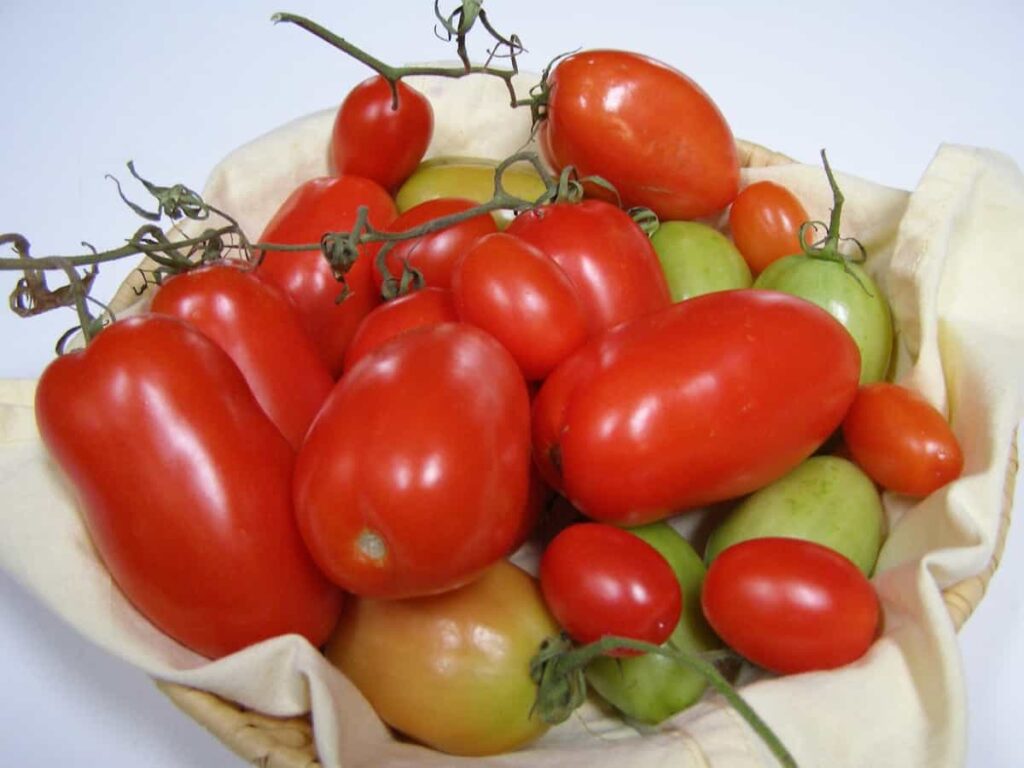
How to grow Roma tomatoes in raised garden beds?
If you want to grow Roma tomatoes in raised garden beds, here are the steps you should take. First, make sure you choose a good spot for your garden bed. It should be in an area with plenty of sunlight and good drainage. It would help if you also ensured the soil in your garden bed is loose and well-drained. To prepare the soil, mix in some compost or organic matter. This will help the plants grow strong and healthy.
Once the soil is ready, you can plant the tomatoes. Space them about 18 inches apart, so they have room to grow. Water the plants regularly, especially during hot weather. Tomatoes need about 1 inch of water per week. If it doesn’t rain, you’ll need to water them yourself. Be careful not to over-water, as this can drown the plants. Once the plants start to grow, you’ll need to prune them, so they don’t get too wild.
When suckers appear between the main stem and branches, pinch them off with your thumb and fingers. You can also trim back any side shoots longer than 6 inches. This will encourage the plant to put all its energy into producing fruit instead of leaves and stems. As the fruit starts to ripen, you may need to support the branches with cages or stakes, so they don’t break under the weight of the fruit. Harvest when the fruit is ripe, and enjoy!
How to grow Roma tomatoes in a bucket
If you want to grow Roma tomatoes in a bucket, you’ll need to start with a 5-gallon bucket. Fill the bucket with potting mix, and make a hole in the center of the potting mix. You need to place the tomato plant in the hole, and then fill it in around the plant with more potting mix. Water the tomato plant well, and then place the bucket in a sunny spot. You’ll need to regularly water your Roma tomato plant, especially during hot weather.
Check the soil before watering, as you want to conserve your plant. If the top few inches of plant soil are dry, it’s time to water your plant. Once your Roma tomato plant starts producing fruit, you’ll need to support the vines with a tomato cage or stake. Otherwise, the heavy fruit will cause the vines to droop over. Harvest your Roma tomatoes when they’re bright red and slightly soft to the touch. Cut them from the vine with a sharp knife, careful not to damage the plant. Enjoy your fresh Roma tomatoes!
Roma tomato spacing
When spacing your Roma tomatoes, give them about 24 to 36 inches of space. You can space them closer together if you are growing them in a pot or raised bed, but they will need more room if you grow them in the ground. You can space them closer together if you are growing them in buckets.
In case you missed it: Vertical Tomato Farming: Modern Way of Getting More Yields in Less Space
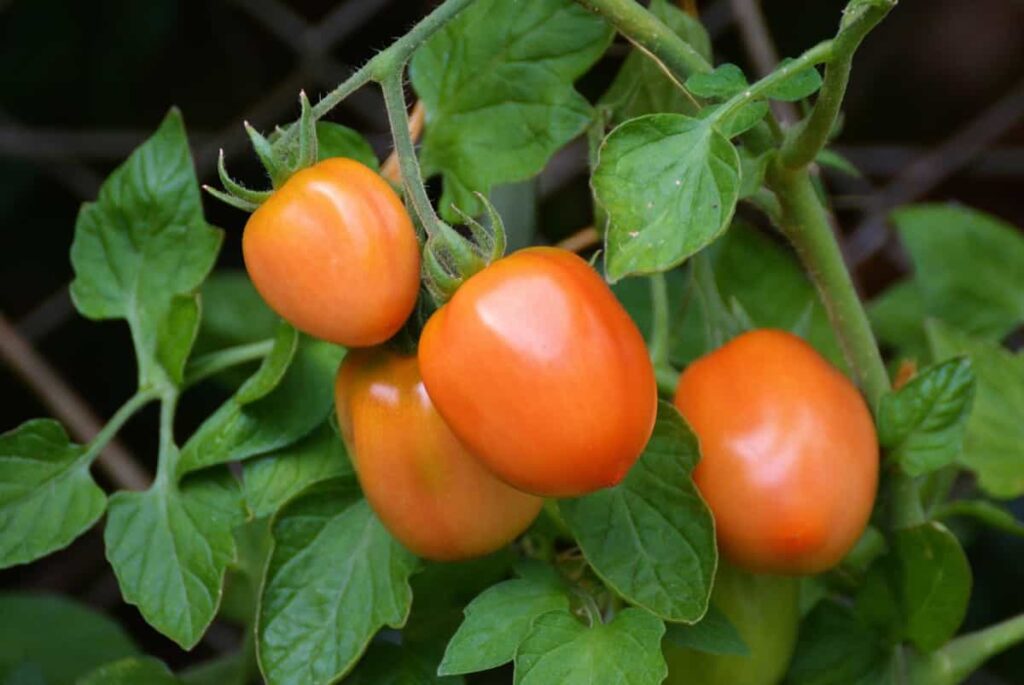
How to stake Roma tomatoes
Roma tomatoes are a delicious and easy-to-grow variety of tomatoes. They are perfect for sauces, canning, and making a paste. Roma tomatoes can be grown in pots, ground, raised beds, or buckets. Here is a guide on how to stake Roma tomatoes. Tomatoes need support as they grow and produce fruit. Staking supports tomato plants so they can grow tall and produce abundant fruits. There are many different ways to stake tomatoes.
The most common method is to use metal or wood stakes driven into the ground next to the plant. Tomato cages are another popular option. Cages can be made from wire mesh or metal fencing material. When staking tomatoes, it is important to drive the stake deep enough into the ground so it will not blow over in strong winds. The stake should also be tall enough to support the entire plant without blocking sunlight from reaching the leaves.
It is best to tie the tomato plant to the stake using soft twine or strips of cloth, so the stem is not damaged. Staking tomato plants will result in healthier plants with more fruit production. It only takes a few minutes per plant and will pay off in the long run.
How often do you water Roma tomatoes?
Tomatoes are a popular vegetable grown in home gardens, and the Roma variety is among the most popular to grow. But how often should I water my tomato plants? Watering frequency depends on a few factors, including the growth stage, weather conditions, and type of container. In general, young tomato plants need watering more frequently than mature plants. During hot, dry weather, you need to water your Roma tomatoes every day or even twice a day. However, if it rains frequently, you may only need to water every few days or even once a week.
The type of container can also affect watering frequency. Plants in pots or other containers will dry out more quickly than in the ground, so they need to be watered more often. Check the soil before watering if you need clarification on whether your tomato plant needs water. If you find it’s dry several inches below the plant’s surface, it’s time to water.
How long do Roma tomatoes take to grow?
Roma tomatoes are determinate tomatoes, meaning they grow to a set size and stop growing. They typically take about 80 days from transplanting to harvest. However, some cultivars mature earlier or later than others. Some may take as little as 60 days, while others take over 100 days. If you are growing Roma tomatoes in containers, they may be ready to harvest a few days sooner than if you are growing them in the ground.
How tall do Roma tomato plants grow?
Roma tomato plants are one of the most popular varieties of tomatoes. Roma tomato plants can produce many fruits that are great for canning and cooking. Roma tomato plants can grow tall, reaching heights of 6 to 7 feet. However, they can also be pruned and kept shorter if desired.
In case you missed it: High Yield Hybrid Tomato Varieties in India: For Winter, Summer, and Rainy Season
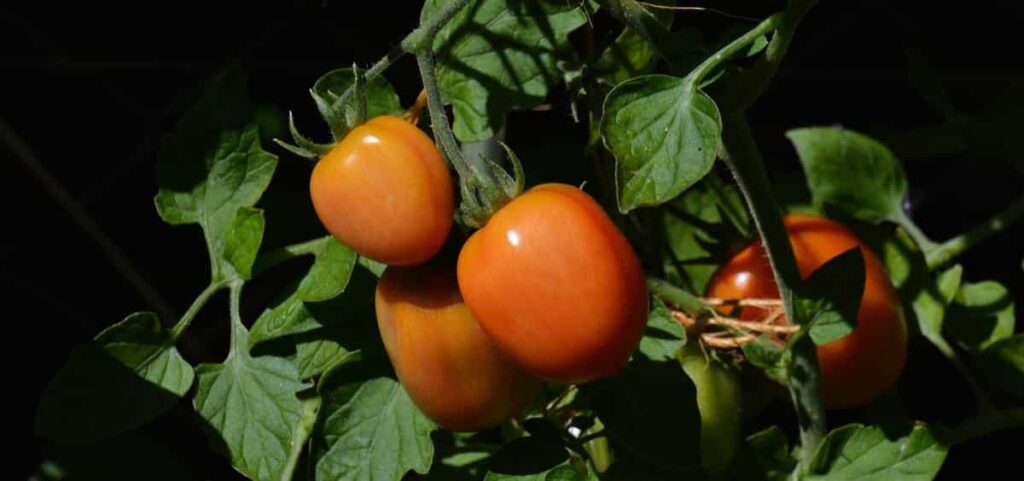
Roma tomato pests and diseases
Several pests and diseases can affect Roma tomatoes. The most common include:
- Aphids – these small, sap-sucking insects can cause stunted growth and distortions in new leaves and stems. They can also transmit viral diseases between plants.
- Tomato hornworms – the larvae of hawk moths, these voracious eaters that can quickly destroy a plant, devouring leaves, stems, and fruit.
- Fusarium wilt – a soil-borne fungus that affects the plant’s vascular system, causing wilting and eventual death.
- Verticillium wilt – another soil-borne fungus that clogs the vascular system, causing yellowing of leaves, stunted growth, and early death.
To combat these pests and diseases in Roma tomato plants, it is important to practice good cultural practices such as crop rotation, using disease-resistant varieties where possible, and keeping the garden area clean and free of debris. In addition, many organic pesticides and fungicides can be used to control pests and diseases on Roma tomatoes.
Growing Roma tomatoes organically
Roma tomatoes are a popular type of tomato often used in cooking. They are relatively easy to grow and can be grown organically with effort. Here are some tips, ideas on how to grow Roma tomatoes organically:
- Start with high-quality organic seedlings. Please ensure they are healthy and robust and that they have been raised without synthetic pesticides or fertilizers.
- Choose a sunny spot in your garden for planting. Roma tomatoes need at least six hours of sunlight per day to thrive.
- Prepare the soil before planting using compost or other organic matter. This will help the tomatoes to grow well and produce lots of fruit.
- Water regularly, especially during dry periods. Tomatoes need consistent moisture to produce good fruit.
- Apply an organic fertilizer during the growing season to boost the plants. You can also add some organic matter to the soil around the plants to help them along.
- Keep an eye out for pests and diseases, and act quickly if you see any problems developing. Treat with organic methods such as neem oil or Bacillus thuringiensis (BT), if possible, to avoid using harmful chemicals in your garden. With little care and attention, you can grow delicious Roma tomatoes organically in your backyard!
How many times can you harvest Roma tomatoes?
Tomatoes are usually harvested about 60 days after planting when the fruit is fully ripe and has turned red. However, depending on the exact variety, a tomato plant can produce fruit for 2-3 months before the plant starts to decline. This means you can harvest tomatoes from a single plant multiple times throughout the growing season. If you’re growing Roma tomatoes specifically, you can expect about 6-8 fruits per plant.
In case you missed it: High Yield Hybrid Paddy/Rice Varieties in India: For Rabi and Kharif Seasons

Again, this will vary depending on the exact variety of Roma tomatoes you’re growing. Some varieties may produce more fruit, while others may produce less. So, you can harvest Roma tomatoes multiple times over a few months. The exact number of times will depend on the variety of tomatoes you’re growing and how many fruits each plant produces.
How many Roma tomatoes do you get per plant?
Roma tomatoes are a popular variety of tomatoes that are known for their oblong shape and fleshy texture. They are often used in cooking because of their high acidity and low water content. Roma tomatoes typically yield about 10-15 fruits per plant.
Do Roma tomato plants come back every year?
Roma tomato plants are determinate plants, meaning they grow to a specific size and then stop. This also means that they have a shorter life span than indeterminate varieties. However, with proper care, Roma tomato plants can produce fruit for two to three years.
What are the best ways to grow Roma tomatoes?
The best way to grow Roma tomatoes will vary depending on location and climate. If you live in hot, humid climatic regions, then growing Roma tomatoes in pots or raised beds are the best option. On the other hand, growing Roma tomatoes in the ground or buckets are the best option if you live in a cooler climate.
What are the best fertilizers to use on Roma tomatoes?
Roma tomatoes are a versatile and popular type of tomato that can be grown in various ways. They are well suited to be grown in pots, on the ground, raised beds, or in buckets. The best fertilizer for Roma tomatoes will vary depending on the growth method. For tomatoes grown in pots, it is best to use a slow-release fertilizer that will last for several months. This will provide a steady supply of nutrients to the plants without having to be applied too frequently.
Granular fertilizer can be used for tomatoes grown on the ground or raised beds. This should be applied once every few weeks during the growing season. Buckets are an ideal way to grow Roma tomatoes if space is limited. A bucket with drainage holes drilled in the bottom can be filled with potting mix, and then one or two plants can be placed inside. A water-soluble fertilizer can be added to the water when watering the plants. This will provide nutrients directly to the roots and avoid any runoff.
In case you missed it: How to Grow Cherry Tomatoes at Home: from Seeds and Tomatoes in Pots, Indoors, and Planting, Care
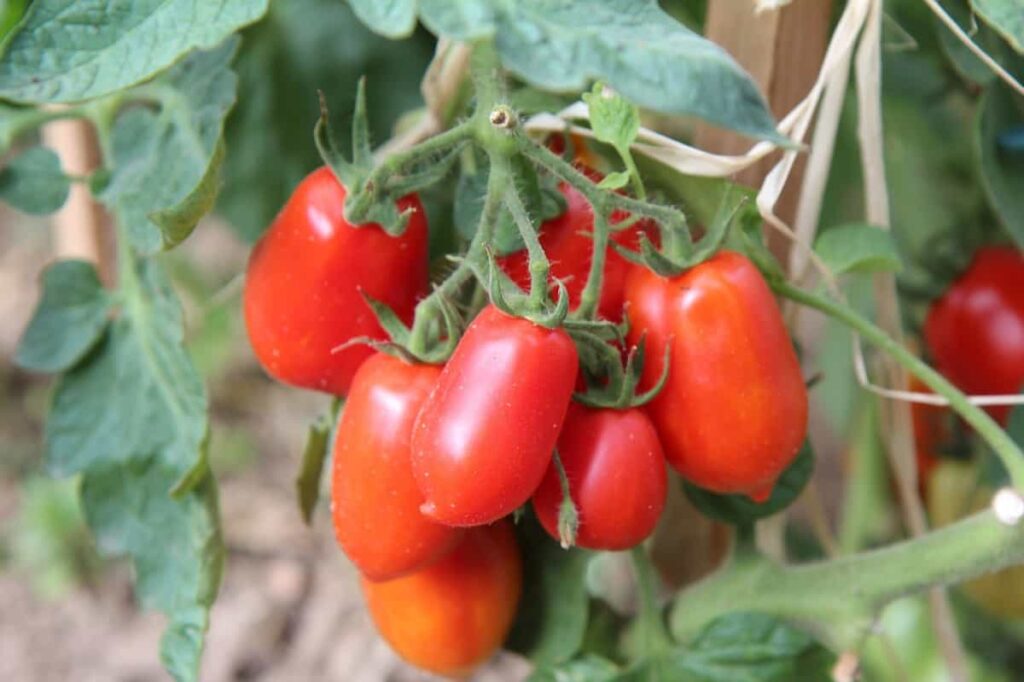
Should I prune Roma tomato plants?
Pruning Roma tomato plants can help to encourage fruit production and improve air circulation, reducing the risk of fungal diseases. When pruning, remove any dead or diseased leaves and stems, as well as any suckers that are growing from the base of the plant. Leave around 4-5 main branches on each plant so that it can continue to produce fruit.
Conclusion
Growing Roma tomatoes is a great way to enjoy fresh, homegrown tomatoes all summer. By following the tips in this guide, you will be well on your way to growing healthy and delicious tomatoes that you can enjoy in salads, sauces, and more. So what are you waiting for? Get out there and start growing Roma tomatoes today!
- How to Raise Pigs in Your Own Backyard: A Comprehensive Guide
- Budget Friendly Sheep Shed Ideas: Cheap and Low-Cost Tips
- How Much Do Cattle Farmers Make: Revenue Streams in Cattle Farming
- Management Pests and Diseases in Your Cotton Field
- Sheep Farming Business Plan for Beginners
- Aquaponic Farming at Home: A Step-By-Step Guide
- Profitable Village Farming Business Ideas in 2024
- High-Yield Aquaculture: Fast-Growing Fish for Farming
- Effective Fish Pond Construction Techniques for Beginners
- Irrigation and Water Management in Pineapple Farming
- Blossom to Harvest: Mastering Flowering and Pollination in Papaya Farming
- Pig Fattening Essentials: From Selection to Sale for Beginners
- Raising Wagyu Cattle: A Complete Guide for Premium Beef Production
- Soil Types and Their Water Holding Capacity
- Optimizing Irrigation Schedules for Coconut Groves for Enhanced Yield
- Espresso Your Garden: Coffee Grounds for Healthier Acid-Loving Plants
- The Best Soil Mix for Snake Plants: How to Mix Your Own Snake Plant Soil
- Green Thumb Success: Expert Tips for Cultivating Greenhouse Beans All Year Round
- Bloom All Year Round: The Ultimate Guide to Indoor Hyacinth Care
- Eco-Friendly Gardening: How to Make Liquid Fertilizer from Kitchen Waste
- Ultimate Guide to Grow Anise in Pots: Explore Seed Propagation to Harvesting
- Guide to Raising Chester White Pigs: Discover Breed Facts to Growth Management
- Mastering the Elegance: The Ultimate Guide to Weeping Cherry Tree Care, Planting, and Maintenance
- Ultimate Guide to Planting Garlic in Grow Bags: Growing Strategies for Beginners
- How to Fix Spider Plant Leaf-Related Problems: Natural and Organic Remedies
- 10 Reasons Why Your Tulsi Plant is Shedding Leaves: Home Remedies and Solutions
- Optimizing Growth and Yield: The Advantages of Palm Bunch Ash Fertilizer
- Utilizing Neem Oil Extract as a Natural Pesticide for Hydrangea
- From Soil to Harvest: Various Ways in Which Farmers Can Use AI Tools
- Steps to Encourage and Induce Citrus Flowers: A Comprehensive Guide
- How to Fix Snake Plant Leaf-Related Issues: Natural and Organic Remedies
- Transform Your Garden into a Fragrant Oasis with Raat Ki Rani (Night Blooming Jasmine)
- Discover the Ideal Chicken Breeds for Philippine Farms
- How to Create a Poultry Egg Farm Business Plan for Profits
- Grow Lemon Cucumbers Like a Pro: Insider Techniques for Bountiful Yields
- Ultimate Guide to Caring for Your Pink Princess Philodendron: Tips for Thriving Variegation

How can I get the seed from kenya